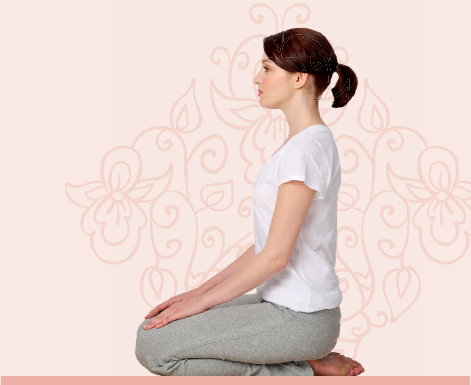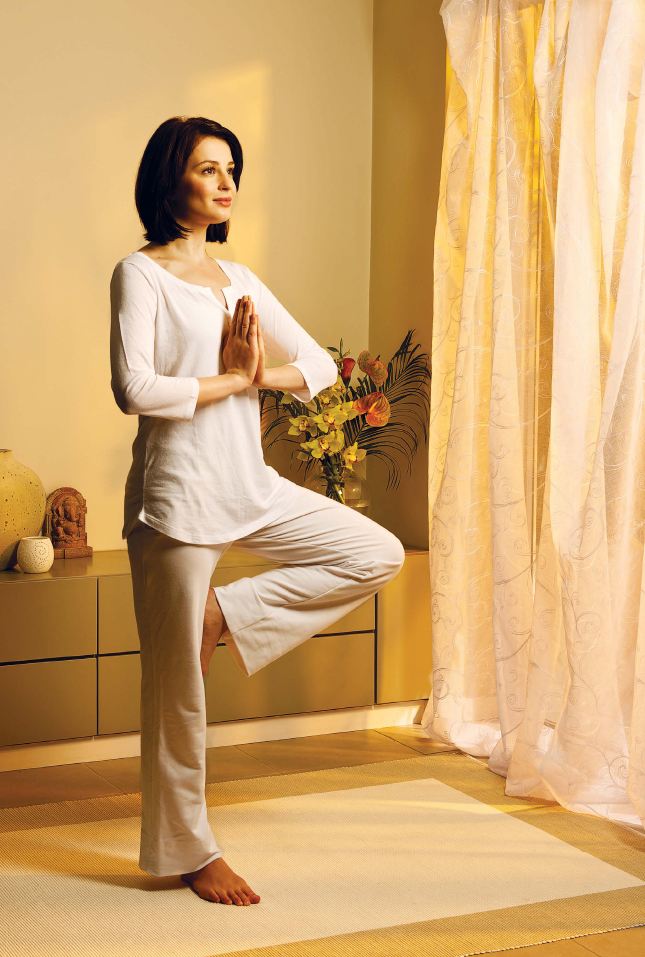

This chapter is where you learn how to put all the Yoga Meditation practices in this book together in the form of routines of different lengths – with five choices for both the morning and the evening – depending on your individual requirements.
Although in our busy lives we often don’t have as much time as we might like to practise yoga and meditation, there is usually a way to fit in at least 15 minutes of practice a day, whether that means getting up 15 minutes earlier or going to bed 15 minutes later. The shortest of the routines in the pages that follow is therefore 15 minutes long, while the longest, most beneficial one is 1 hour 45 minutes long. The more regularly you can commit to one or more of these routines, the greater sense of inner peace, contentment and connectedness you are likely to experience in daily life.
In order to obtain optimum benefits from your Yoga Meditation, it is, however, essential that you lead a lifestyle that is fully supportive of your goals off the yoga mat as well as on it. Guidance is therefore given on a healthy overall, daily routine, including what time to get up and go to bed, an optimal cleansing routine and the ideal diet.
In order to really get the most from the Yoga Meditation practices in this book, it is important to maintain a balanced all-round lifestyle to complement them. Commitment to optimum health requires not only sufficient exercise and dedication to a spiritual practice such as Yoga Meditation, but also wholesome nutrition, adequate relaxation and sufficient sleep.
In yogic terms, it is important to keep the body and mind healthy not only in order to feel physically fit but also so that they remain fit vehicles through which the true divine inner Self can express itself, allowing you to experience a sense of oneness and harmony in life.
The following daily guidelines will help you to maintain a healthy and balanced body and mind to this end. Although it may not always be possible to follow all the guidelines within the restraints of busy, modern life, any that you do follow will be of enormous benefit.
According to yogic thinking, the early morning (before 6 am) is filled with prana, making this the best period to get up in the morning and also the most rewarding time to meditate.
The period between 4 and 6 am is believed to be when lightness and clarity predominate, and your mind and body have maximum chance for feeling fresh. Sleeping beyond 6 am, on the other hand, is likely to make us feel more sluggish, tired and experience slow movement of the bowels.
It is important as soon as you get up in the morning to go to the toilet and get your bladder and bowels moving. If a bowel movement does not come easily, try drinking a mug of hot water with half a fresh lemon squeezed into it, a pinch of salt and a teaspoon of honey. Then drink another mug of plain warm water. The lemon and salt have a cleansing, drawing-out effect, and the honey is a tonic for the colon.
It is important to regularly remove toxins and bacteria from your body. So at least twice a day, use a small or medium soft-bristled toothbrush to carefully brush your teeth. Ayurveda, Indian traditional medicine, recommends a toothpaste with astringent, bitter and pungent flavours, such as myrrh, propolis, neem or peppermint. A toothpaste that contains baking soda is also good. Once you have brushed your teeth, also floss between them to dislodge any bacteria. It is also recommended that you gently scrape your tongue with a tongue scraper or the edge of a teaspoon to remove the bacterial coating and to dispel bad breath. Finally, gargle with a little warm water to clear and soothe your throat.
It is good yogic practice to regularly use what is called a neti pot (similar to a small teapot, but with a special spout) to rinse out your nasal passages. To do so, fill the pot with warm water and dissolve one teaspoon of salt in it. Leaning over a washbasin, tilt your head to the left side and placing the spout slightly in the right nostril, slowly pour the water up your nose so that it flows out of the left nostril. The warm salty water flushes out mucus and dust, cleansing the lining of the nostrils. To expel the excess of water from your nostrils, breathe in and out rapidly through the nose.
Digestive remedy

If you suffer from constipation, bloating, flatulence or indigestion, you can try drinking triphala (available to buy from reputable herbal suppliers) – an Ayurvedic powder remedy blended from three fruits: haritaki, bibhitaki and amalaki. Dissolve one teaspoonful of triphala powder in a mug of hot water, then let it stand for a few minutes before drinking. It is best taken in the evening, half an hour before sleep.
Ayurveda recommends daily massage, if possible, before a bath, to encourage the release of waste products from the body. Massaging the skin stimulates blood circulation and encourages the flow of lymph. It also cleanses, nourishes, relaxes and rejuvenates the body.
• Warm some sesame oil (organic, cold-pressed, and less than six months old). If it irritates your skin, use coconut oil or sweet almond oil instead.
• Sit on a bath towel and apply the warm oil all over your body from head to foot, taking about ten minutes to do so. Use up and down or circular movements of your hands to smooth the oil into your skin.
• Then relax for five minutes to allow your skin to absorb the oil.
• If you are pressed for time, a two- or three-minute massage is still useful, focusing mainly on your head and feet.
After your oil massage, take a warm bath or shower using a mild soap to cleanse the oil from your skin.
Sadhana is a Sanskrit word meaning “spiritual” practice. Having thoroughly cleansed your body, you can now put on clean, comfortable clothes and begin your Yoga Meditation sadhana from this book (see pages 146–53 for options of sessions of varying lengths, combining the practices in the book). It is important to be regular in your daily sadhana, as its purpose is for you to discover your true joyful inner Self and to feel at peace with the world.
Eat a nourishing light breakfast such as fresh fruit of your choice, muesli with a few soaked and peeled almonds, porridge of oats, millet or buckwheat flakes, or buckwheat pancakes, alongside a cup of herbal tea, in a calm, pleasant atmosphere – in silence if possible.
What is known in yogic terms as the “digestive fire” is at its strongest and most efficient at midday. Eat in a relaxed atmosphere – in silence if possible. Chew your food well. And do not dilute your digestive juices by drinking glasses of water or juice while eating; instead, allow half an hour after food before drinking. Sit quietly for five minutes, then take a short walk of up to 15 minutes if you can to aid digestion. Then resume your afternoon activities. The hours between 2 and 6 pm are optimal for mental activities.
After any evening Yoga Meditation practice, have a light dinner, ensuring that you have left at least three hours since lunch for adequate digestion. It is best to avoid yogurt, animal protein and raw ingredients at this time as they are hard to digest. Do not read or watch television while you eat. And try to eat only three-quarters of your capacity; stop when you are comfortably full.
Yoga agrees with the maxim “early to bed early to rise, makes a person healthy, wealthy and wise”. To ensure you get a full night of deep rest, which is vital for optimum health, go to bed no later than 10 pm. Between 10 pm and 2 am is believed to be an active period of the night, so if you are awake then, it will make you feel lively, alert and unlikely to have a good night’s rest. Staying up late may also contribute to insomnia, digestive and elimination problems, high blood pressure and poor concentration.
For all-round development of both your mind and body, and to awaken and harness your physical and mental energy, it is best to practise Yoga Meditation twice a day if at all possible – once when you get up in the morning to start the day off well and again in the evening to help you unwind – even if it is only 15 minutes each time. Alternatively, if you have more time either in the morning or evening, you could opt for a longer practice then.
The selection of timed Morning and Evening Routines that follows has been specially created from the many invaluable practices explained throughout this book. Choose which of the five timed routines (15 minutes, 30 minutes, 1 hour, 1 hour 15 minutes, or 1 hour 45 minutes) best suits you depending on how much time you have and which practices you are comfortable with at this stage on your Yoga Meditation journey. Remember to reassess your timing needs every now and then in order to get the most from your practice.
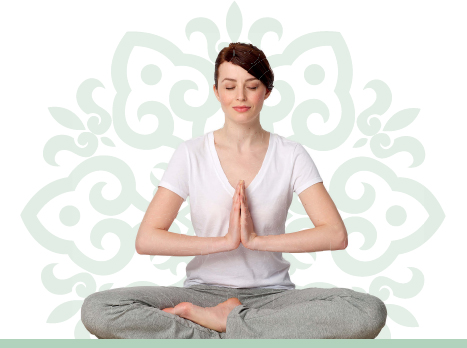
Practice and time

The routines that follow are flexible, so if you sense that it is beneficial to give more attention to certain techniques, then by all means do so. But always try to give as much time as you can to the meditation practices (for example, at the weekend you might have time to do longer meditations), as experiencing stillness, peace and a sense of connectedness in meditation is ultimately the aim of all the practices.
Please bear in mind that the timings given are approximate, based on how long it takes an average practitioner to do them. However, every individual works at their own pace so do leave some flexibility around the suggested timings, especially if you are new to yoga and meditation. Do not feel worried if some practices take more or less time to do. Note also that any discrepancy between the length of time suggested for a practice in the following routines and given in the main entry for that practice is because the timings here have been amended to work within each routine’s timed framework.

In the Spirit of Meditation
More important than when and where you meditate, or what techniques you use, are your attitude and the spirit of the heart in which you practise, and your self-discipline and regularity in practising meditation. Through regular, disciplined practice you will develop your awareness, wisdom, energy and joy to a level that you can skilfully integrate your experience of centred inner calm, peace and joy into your everyday life.
The morning routines on the right will awaken the energy within you, giving you the vitality you need to start the day. The combination of recommended practices within each routine will encourage free circulation of vital forces, stimulating your glands, improving blood and lymph circulation, and releasing body wastes as well as any mental-emotional tensions and blockages. The result of doing these routines regularly will be increased energy, enhanced clarity and a calmer mind.
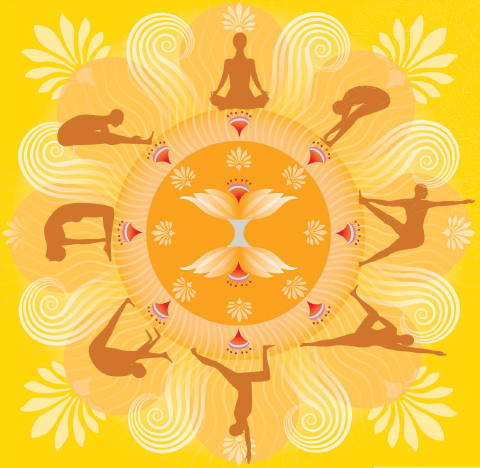
1 Purification practices
• Nadi Shodhana
3 minutes; see pages 86–7
• Agnisara Kriya
2 minutes; see pages 88–9
2 Meditation practices
• Hong Sau
10 minutes; see pages 122–5
1 Asana Practices
• Warming up
5 minutes; see pages 64–7
• Sun Salutation Sequence
10 minutes; see pages 68–71
2 Meditation Practices
• Maha Mudra
5 minutes; see pages 114–17
• Hong Sau
10 minutes; see pages 122–5
1 Asana practices
• Warming up
5 minutes; see pages 64–7
• Energizing Morning Sequence
10 minutes; see pages 72–5
2 Purification practices
• Nadi Shodhana
5 minutes; see pages 86–7
3 Pranayama practices
• Complete Yogic Breath
5 minutes; see pages 96–7
• Bhastrika Pranayama
5 minutes; see pages 100–101
4 Meditation practices
• Maha Mudra
5 minutes; see pages 114–17
• Hong Sau
10 minutes; see pages 122–5
• Navi Kriya
5 minutes; see pages 126–7
• Om Meditation
10 minutes; see pages 132–3
1 Asana practices
• Warming up
5 minutes; see pages 64–7
• Sun Salutation Sequence:
10 minutes; see pages 68–71
2 Purification Practices
• Nadi Shodhana
5 minutes; see pages 86–7
• Agnisara Kriya
3 minutes; see pages 88–9
• Kapalabhati
5 minutes; see page 92
• Ashvini Mudra
2 minutes; see page 93
3 Meditation practices
• Maha Mudra
5 minutes; see pages 114–17
• Hong Sau
15 minutes; see pages 122–5
• Navi Kriya
5 minutes; see pages 126–7
• Om Meditation
20 minutes; see pages 132–3
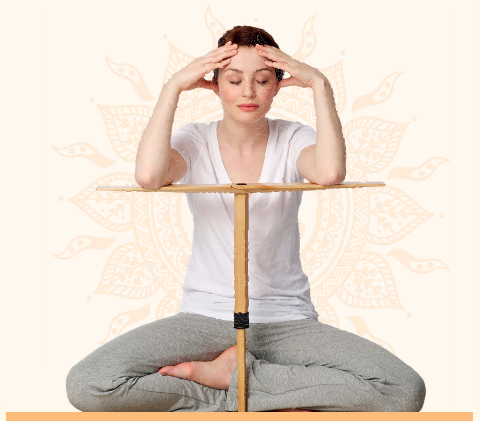
1 Asana practices
• Warming up
5 minutes; see pages 64–7
• Sun Salutation Sequence
10 minutes; see pages 68–71
• Energizing Morning Sequence
10 minutes; see pages 72–5
2 Purification practices
• Nadi Shodhana
5 minutes; see pages 86–7
• Agnisara Kriya
3 minutes; see pages 88–9
• Kapalabhati
5 minutes; see page 92
• Ashvini Mudra
2 minutes; see page 93
3 Pranayama practices
• Complete Yogic Breath
5 minutes; see pages 96–97
• Bhastrika Pranayama
5 minutes; see pages 100–101
• Bhramari Pranayama
5 minutes; see page 102–3
• Kundalini Pranayama
5 minutes; see pages 104–5
4 Meditation practices
• Maha Mudra
5 minutes; see pages 114–17
• Bija mantras
5 minutes; see pages 118–19
• Hong Sau
10 minutes; see pages 122–5
• Navi Kriya
5 minutes; see page 126–7
• Om Meditation
20 minutes; see pages 132–3
“Be calmly active, and actively calm. That is the way of a yogi. Meditate regularly, and you will find a joy inside that is real.”
Paramhansa Yogananda
The evening routines that follow focus mainly on practices that have a relaxing effect on your mind and body at the end of a busy day. If you are doing a routine that involves asana and pranayama practices, it is best to do it just after work, whereas a meditation-based routine is more suitable for just before bedtime to ensure a good night’s sleep.
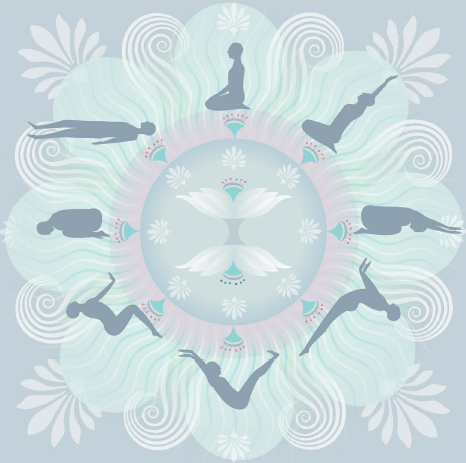
1 Meditation practices
• Maha Mudra
5 minutes; see pages 114–17
• Hong Sau
10 minutes; see pages 122–5
1 Meditation practices
• Maha Mudra
5 minutes; see pages 114–17
• Hong Sau
10 minutes; see pages 122–5
• Ultimate Bliss Yoga Meditation
15 minutes; see pages 134–7
1 Meditation practices
• Maha Mudra
5 minutes; see pages 114–17
• Hong Sau
10 minutes; see pages 122–5
• Jyoti Mudra
5 minutes; see pages 128–9
• Om Meditation
10 minutes; see pages 132–3
• Ultimate Bliss Yoga Meditation
30 minutes; see pages 134–7
1 Asana practices
• Warming up
5 minutes; see pages 64–7
• Relaxing Evening Sequence
10 minutes; see page 76–9
2 Purification practices
• Nadi Shodhana
5 minutes; see pages 86–7
3 Pranayama practices
• Ujjayi Pranayama
5 minutes; see pages 98–9
4 Meditation practices
• Steady gazing
5 minutes; see page 113
• Maha Mudra
5 minutes; see pages 114–17
• Hong Sau
10 minutes; see pages 122–5
• Jyoti Mudra
5 minutes; see pages 128–9
• Om Meditation
10 minutes; see pages 132–3
• Ultimate Bliss Yoga Meditation
15 minutes; see pages 134–7

Mastering the art of meditation
It is important to remember that meditation requires dedication and discipline, so do not give up on it before you have given it a proper chance. If you find it difficult to sit in stillness, the trick is simply to set aside more time for each meditation session. By being willing to sit for a longer period of time, you will allow your thoughts more time to slow and settle down. As most experienced meditators will tell you, true meditative stillness usually occurs after between 45 minutes and an hour. To reach this state, you will need to persist with a steady effort. If you feel a resistance to sitting, simply try to let go of the thoughts that are holding you back and bring your attention and awareness back to your breath or the mantra Om.
1 Asana practices
• Warming up
5 mins; see pages 64–7
• Relaxing Evening Sequence
10 minutes;see pages 76–9
• Cool Down Sequence
10 minutes; see pages 80–83
2 Purification practices
• Nadi Shodhana
5 minutes; see pages 86–7
3 Pranayama practices
• Ujjayi Pranayama
5 minutes; see pages 98–9
• Bhramari Pranayama
5 minutes; see pages 102–3
4 Meditation practices
• Maha Mudra
5 minutes; see pages 114–17
• Bija mantras
10 minutes; see pages 118–19
• Hum mantra
5 minutes; see pages 120–21
• Hong Sau
10 minutes; see pages 122–5
• Om Meditation
15 minutes; see pages 132–3
• Ultimate Bliss Yoga Meditation
20 minutes; see pages 134–7
